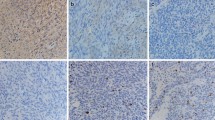Abstract
Thioredoxin (Trx) is a redox active protein that regulates several physiological and biochemical functions, such as growth, apoptosis and cellular defense. The function of Trx itself is regulated by thioredoxin reductase (TrxR). This study was designed to determine the expression of TrxR1 in meningioma tissues of different World Health Organization grades (grade I–III). Meningioma tissues were extracted from the histopathological specimens of 29 patients. These samples included seven histologically normal meningeal tissues that served as a control group and 12 grade I, 12 grade II and 5 grade III meningioma samples. TrxR1 expression was evaluated using quantitative reverse transcription polymerase chain reaction (qRT-PCR) and immunostaining. The proliferative and apoptotic indices of the specimens were investigated by Ki-67 immunostaining and TUNEL assay, respectively. TrxR1 expression, as assessed by qRT-PCR, increased significantly with meningioma grade (p < 0.001). The immunostaining intensity of TrxR1 increased significantly with meningioma grade (p < 0.001). Ki-67 index values increased significantly in accordance with grade progression (p < 0.001). The apoptotic index values were not significantly different in any group (p > 0.05). Trx system seems to be involved in the malignant progression of meningiomas. Further, large studies are required to elucidate the exact role of this system.


Similar content being viewed by others
References
Wrobel G, Roerig P, Kokocinski F, Neben K, Hahn M, Reifenberger G, Lichter P (2005) Microarray-based gene expression profiling of benign, atypical and anaplastic meningiomas identifies novel genes associated with meningioma progression. Int J Cancer 114(2):249–256
Louis DN, Scheithauer BW, Budka H, von Deimling A, Kepes JJ (2000) Meningiomas. In: Kleihues P, Cavenee WK (eds) Pathology and genetics of tumours of the nervous system. IARC Press, Lyon, pp 176–189
Haapasalo H, Kyläniemi M, Paunul N, Kinnula VL, Soini Y (2003) Expression of antioxidant enzymes in astrocytic brain tumors. Brain Pathol 13(2):155–164
Kemerdere R, Kacira T, Hanimoglu H, Kucur M, Tanriverdi T, Canbaz B (2013) Tissue and plasma thioredoxin reductase expressions in patients with glioblastoma multiforme. J Neurol Surg A Cent Eur Neurosurg 74(4):234–238
Yagublu V, Arthur JR, Babayeva SN, Nicol F, Post S, Keese M (2011) Expression of selenium-containing proteins in human colon carcinoma tissue. Anticancer Res 31(9):2693–2698
Biaglow JE, Miller RA (2005) The thioredoxin reductase/thioredoxin system: novel redox targets for cancer therapy. Cancer Biol Ther 4:6–13
Berggren M, Gallegos A, Gasdaska JR, Gasdaska PY, Warneke J, Powis G (1996) Thioredoxin and thioredoxin reductase gene expression in human tumors and cell lines, and the effects of serum stimulation and hypoxia. Anticancer Res 16:3459–3466
Choi JH, Kim TN, Kim S, Baek SH, Kim JH, Lee SR, Kim JR (2002) Overexpression of mitochondrial thioredoxin reductase and peroxiredoxin III in hepatocellular carcinomas. Anticancer Res 22:3331–3335
Kakolyris S, Giatromanolaki A, Koukourakis M, Powis G, Souglakos J, Sivridis E, Georgoulias V, Gatter KC, Harris AL (2001) Thioredoxin expression is associated with lymph node status and prognosis in early operable non-small cell lung cancer. Clin Cancer Res 7:3087–3091
Esen H, Erdi F, Kaya B, Feyzioglu B, Keskin F, Demir LS (2014) Tissue thioredoxin reductase-1 expression in astrocytomas of different grades. J Neurooncol (Epub ahead of print). doi:10.1007/s11060-014-1661-5
Järvelä S, Bragge H, Paunu N, Järvelä T, Paljärvi L, Kalimo H, Helén P, Kinnula V, Soini Y, Haapasalo H (2006) Antioxidant enzymes in oligodendroglial brain tumors: association with proliferation, apoptotic activity and survival. J Neurooncol 77:131–140
Ahmadi R, Urig S, Hartmann M, Helmke BM, Koncarevic S, Allenberger B, Kienhoefer C, Neher M, Steiner HH, Unterberg A, Herold-Mende C, Becker K (2006) Antiglioma activity of 2,2′:6′,2′′-terpyridineplatinum[II] complexes in a rat model-effects on cellular redox metabolism. Free Radic Biol Med 40:763–778
Ford JM, Seiferheld W, Alger JR, Wu G, Endicott TJ, Mehta M, Curran W, Phan SC (2007) Results of the phase I dose-escalating study of motexafin gadolinium with standard radiotherapy in patients with glioblastoma multiforme. Int J Radiat Oncol Biol Phys 69:831–838
Huang T, Jin X, He L, Zhang M, Wu J, Wang Y, Fang J (2013) Role of podocalyxin in astrocytoma: clinicopathological and in vitro evidence. Oncol Lett 6(5):1390–1396
Stafford SL, Perry A, Suman VJ, Meyer FB, Scheithauer BW, Lohse CM, Shaw EG (1998) Primarily resected meningiomas: outcome and prognostic factors in 581 Mayo Clinic patients, 1978 through 1988. Mayo Clin Proc 73:936–942
Hanahan D, Weinberg RA (2000) The hallmarks of cancer. Cell 100:57–70
Arnér ES, Holmgren A (2006) The thioredoxin system in cancer. Semin Cancer Biol 16:420–426
Powis G, Kirkpatrick DL, Angulo M, Baker A (1998) Thioredoxin redox control of cell growth and death and the effects of inhibitors. Chem Biol Interact 111–112:23–34
Söderberg A, Sahaf B, Rosén A (2000) Thioredoxin reductase, a redox-active selenoprotein, is secreted by normal and neoplastic cells: presence in human plasma. Cancer Res 60:2281–2289
Yokomizo A, Ono M, Nanri H, Makino Y, Ohga T, Wada M, Okamoto T, Yodoi J, Kuwano M, Kohno K (1995) Cellular levels of thioredoxin associated with drug sensitivity to cisplatin, mitomycin C, doxorubicin, and etoposide. Cancer Res 55:4293–4296
Conflict of interest
All authors certify that they have no conflict of interest.
Author information
Authors and Affiliations
Corresponding author
Rights and permissions
About this article
Cite this article
Esen, H., Feyzioglu, B., Erdi, F. et al. High thioredoxin reductase 1 expression in meningiomas undergoing malignant progression. Brain Tumor Pathol 32, 195–201 (2015). https://doi.org/10.1007/s10014-015-0212-x
Received:
Accepted:
Published:
Issue Date:
DOI: https://doi.org/10.1007/s10014-015-0212-x




